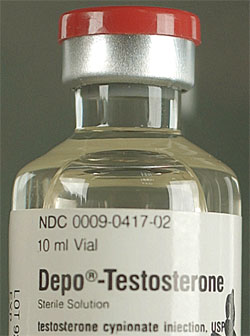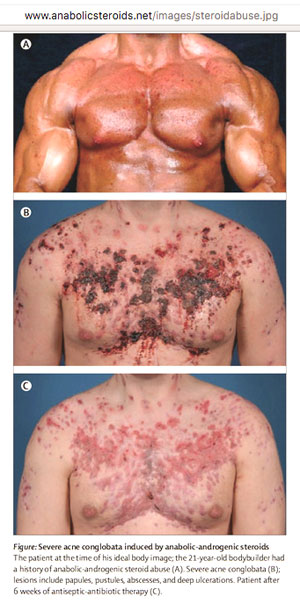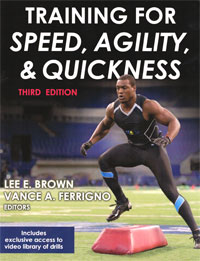|
Anabolic Steroids: Abuse by Athletes
Author:
Stan Reents, PharmD
Original Posting:
05/06/2007 05:01 AM
Last Revision: 11/19/2018 05:24 AM
It seems "steroids" (ie., anabolic steroids) in sports just won't go away. Here are 5 high-profile cases from the past several decades:
HIGH-PROFILE CASE #1: Canadian Sprinter Ben Johnson
In 1988, at the Seoul Olympics, Canadian sprinter Ben Johnson beat American Carl Lewis in the 100-meter dash to win the gold medal. Several days later, it was reported that Johnson tested positive for stanozolol, a very potent anabolic steroid. Even though it was well-known that Russian and East German athletes had been abusing steroids for years, Johnson's violation caused the sporting world to sit up and take notice. Anabolic steroids became a class-III Controlled Substance in the US in 1990.
HIGH-PROFILE CASE #2: BALCO Labs
In March 2002, an anabolic steroid known as "norbolethone" was discovered in a urine sample from an athlete. Norbolethone was studied by Wyeth Pharmaceuticals from 1967 to 1971 but never marketed in the US due to its toxicity. Thus, its reappearance 3 decades later was highly unusual.
In June 2003, an anonymous track coach finds a syringe of clear liquid and mails it to the US Anti-Doping Agency (USADA) in Colorado Springs, Colorado for testing. A previously unknown steroid -- a "designer" steroid -- is discovered. Its chemical name is tetrahydrogestrinone (THG), but on the street, it is referred to as "The Clear".
It turns out that THG and norbolethone are closely related. Also, as with stanozolol, the anabolic-to-androgenic ratio for norbolethone is very high, making both drugs ideal performance-enhancing substances.
Don Catlin, MD, at UCLA, then went to work developing an assay to detect THG. Even though THG was never marketed commercially, suddenly, athletes started turning up positive: Regina Jacobs, an American middle-distance runner, and UK sprinter Dwain Chambers, to name a few. Chambers admitted he was using supplements from BALCO Labs, a Burlingame, California company. THG (aka "The Clear") was traced to this lab.
On September 3, 2003, BALCO was raided and its founder, Victor Conte, was arrested. Conte argued that THG was not a steroid, though, on October 28, 2003, the FDA issued a press release stating that THG was, in fact, an unapproved new drug, and not a dietary supplement. Research published in May 2004 showed that THG was unquestionably a potent anabolic steroid (Death AK, et al. 2004). On December 3, 2004, during a TV interview on ABCs 20/20, Conte implied that Marion Jones, Barry Bonds, and other elite athletes were recipients of substances originating from BALCO.
HIGH-PROFILE CASE #3: Major League Baseball
In February 2005, Jose Canseco's tell-all book Juiced: Wild Times, Rampant 'Roids, Smash Hits, and How Baseball Got Big was published. This book generated tremendous controversy. At congressional hearings in March 2005, baseball greats such as Mark McGwire, Jason Giambi, and Rafael Palmeiro were forced to defend their integrity. Then, in August 2005, Palmeiro was reported to have tested positive for....stanozolol.
HIGH-PROFILE CASE #4: Cyclist Lance Armstrong
American Lance Armstrong was diagnosed with testicular cancer in 1996, then won the grueling Tour de France a record 7 times in a row: 1999 through 2005. It seemed he was a modern day Superman.
For years, rumors circulated that Armstrong was using performance-enhancing drugs. Then, in August 2012, after years of denying it, Armstrong finally decided to accept punishment based on USADA's discussions with other athletes, positive urine tests in 2001 from Lausanne's Anti-Doping Lab, and positive blood tests in 2009 and 2010 obtained by Union Cycliste Internationale (UCI). USADA asserted that he had used and distributed not only the blood-boosting agent erythropoeitin, but anabolic steroids as well. USADA swiftly revoked all 7 of Armstrong's Tour de France titles and banned him from the sport of cycling for life (see this summary from TIME magazine, 8/24/12).
HIGH-PROFILE CASE #5: UFC Fighter Jon Jones
A random drug test in June 2016 of UFC fighter Jon Jones identified clomiphene and letrozole. (Clomiphene and letrozole are not anabolic steroids, but are sometimes used as either masking agents by athletes abusing anabolic steroids, or, to offset the feminizing effects of anabolic steroids.) Then, on July 28, 2017, he tested positive for a metabolite of turinabol, a derivative of the anabolic steroid metandienone (see table below). Turinabol was an oral anabolic steroid developed by an East German pharmaceutical company in the early 1960's and was administered to approximately 10,000 of their athletes as part of a secret doping program by the East German government (the athletes were told they were being given vitamins).
However, Jones's positive turinabol test was measured at an extremely low concentration: between 20 and 80 picograms. Jones had passed tests just 3 weeks earlier. For these reasons, USADA believed that Jones did not intentionally use an anabolic steroid and reduced his sentence. He is scheduled to return to the Octagon on December 29, 2018.
(For more info on significant doping events in competitive sports, see the superb detailed list in "Doping In Elite Sport" (2001) by Wayne Wilson, PhD.)
How did competitive sports get so contaminated with anabolic steroids? A brief history of anabolic steroids follows, but, first, some definitions....
DEFINITIONS
In chemistry and medicine, there are 3 general groups of drugs that can be described as "steroids":
• Anabolic Steroids (androgens): This group includes testosterone and all of its derivatives. Testosterone is secreted by the testes and adrenals in males and by the ovaries and adrenals in females.
• Female Steroids (estrogens and progestins): Like testosterone, estrogens and progestins can be found in both sexes. Testosterone is metabolized to estradiol, a specific type of estrogen.
• Corticosteroids (glucocorticoids): These hormones are produced by the adrenal gland and are secreted when the body experiences stress. Glucocorticoids such as cortisol and hydrocortisone can also be called "catabolic" steroids because their actions on many tissues are opposite those of the anabolic steroids.
• Steroid Precursors (androstenedione, DHEA): A 4th category of substances deserves mention here, too. "Steroid precursors" are molecules that, once inside the body, are converted into testosterone. Androstenedione, or "andro" as it is commonly known, and DHEA were once sold as a dietary supplements, but the attitude towards these supplements has changed (see below). Andro is now regarded as a banned substance by many sports governing organizations.
For this discussion, we are only concerned about anabolic steroids.
HISTORY OF TESTOSTERONE, ANDROGENS, AND ANABOLIC STEROIDS
Testosterone was first isolated in 1935. However, testosterone is not absorbed when taken orally, so pharmaceutical companies produced derivatives that could be given by intramuscular (IM) injection or orally. In 1940, methyltestosterone (Android-10®) was the first oral derivative to be marketed, but it had only about 20% the anabolic effect of injectible testosterone (Kochakian CD. 1993).
"Anabolic" effects include the muscle- and strength-building properties, whereas "androgenic" effects include the masculinizing effects. Obviously, increasing the anabolic effects while diminishing the androgenic effects of these steroids is desirable to athletes looking for an unethical advantage.
Over the ensuing 20-25 years, in an effort to produce compounds with higher and higher anabolic potency and minimal androgenic properties, other oral derivatives were developed: fluoxymesterone (Halotestin®), oxymetholone (Anadrol®), and oxandrolone (Oxandrin®). Each of these 3 drugs had more potent anabolic effects than the previous one, yet all 3 also had less androgenic effects than methyltestosterone.
MARKETED
IN THE US |
ANABOLIC STEROID |
DOSAGE FORM |
| • 1940 |
methyltestosterone (Android-10®) |
oral |
| • 1956 |
fluoxymesterone (Halotestin®) |
oral |
| • 1958 |
metandienone (Dianabol®)** |
oral |
| • 1959 |
nandrolone (Durabolin®) |
injection |
| • 1962 |
nandrolone decanoate
(Deca-Durabolin®) |
injection |
| • 1962 |
oxymetholone (Anadrol®) |
oral |
| • 1962 |
stanozolol (Winstrol®)** |
injection, oral |
| • 1964 |
oxandrolone
(Anavar®**, Oxandrin®) |
oral |
** = no longer available in the US
Stanozolol (Winstrol®) was marketed in 1962 and was a dream-come-true for athletes looking for a performance-enhancing drug. The anabolic effects of stanozolol were roughly 10 times the potency of methyltestosterone, while its androgenic effects were about one-third that of methyltestosterone (Kochakian CD. 1993). Stanozolol was removed from marketing in the US in 2003, however, there were reports that NFL players were still obtaining it during the 2003-2004 season.
And, somehow, it got into Rafael Palmeiro's body in 2005, though, apparently, he doesn't know how that happened....
Professional athletes need to realize the impact they have on young athletes. The Centers for Disease Control and Prevention (CDC) reported in its 2000 Youth Risk Behavior Surveillance survey that among high school seniors, 6.4 percent of males and 3.3 percent of females admitted using steroids at least once. If more of these young athletes were aware of the potential dangers, it's likely fewer would ever experiment with these drugs.
MEDICAL USES OF TESTOSTERONE AND ANABOLIC STEROIDS
Both testosterone and anabolic steroids do have legitimate medical uses. These will be discussed in a separate review in the AthleteInMe.com LIBRARY.
SHORT-TERM SIDE EFFECTS OF ANABOLIC STEROIDS

Appearance
While some athletes abuse steroids in hopes of increasing their athletic performance, many others abuse steroids to enhance their physique. Unfortunately, while their muscles may get bigger, they may experience an increase in acne. In some cases, a very severe form known as "acne conglobata" can occur (see images to the right). Severe acne can scar the skin permanently.
In men prone to balding, abuse of steroids may increase hair loss. Women who use steroids with androgenic properties will see an increase in growth of secondary hair (facial hair, forearm hair, etc.).
Psychiatric Effects
Surveys of athletes clearly show an increase in anxiety, hostility, aggression, and suspiciousness during phases of steroid use (Parrott AC, et al. 1994), especially with methyltestosterone. In one study of intramuscular testosterone cypionate, psychiatric symptoms were apparent within 6 weeks, though only a small percentage of men were affected (Pope HG, et al. 2000).
LONG-TERM SIDE EFFECTS OF ANABOLIC STEROIDS
When steroids are used continuously for months and months, more serious side effects can occur:
Appearance
In men, chronic abuse of anabolic steroids can cause the breasts to enlarge. This is known as gynecomastia. In women, anabolic steroids will cause the voice to deepen, the clitoris to enlarge, and the breasts to shrink. Many of these effects are permanent (Kibble MW, et al. 1987).
Liver
Oral anabolic steroids can cause the development of blood-filled cysts in the liver. This condition is known as peliosis hepatis. Liver tumors are possible when orally-administered anabolic steroids are used chronically (Farrell GC, et al. 1975).
Heart
Chronic abuse of steroids can produce a variety of detrimental effects on the heart, including: increased left ventricle size and increased thickness of the ventricular septum (DePiccoli B, et al. 1991) and dilated cardiomyopathy (Ferrera PC, et al. 1997). Once these anatomical changes exist, other cardiac problems are possible: cardiac arrhythmias (Nieminen MS, et al. 1996) and sudden death (Dickerman RD, et al. 1995) have been reported in weight lifters who abuse anabolic steroids.
Cardiovascular
Chronic use of anabolic steroids increases the risk of cardiovascular events. It is thought that there are at least 4 mechanisms (Melchert RB, et al. 1995):
- atherogenesis (ie., harmful effects on blood lipids and blood vessels)
- thrombosis (ie., increased tendency for blood clotting)
- vasospasm (ie., sudden constriction of the coronary arteries)
- direct myocardial injury (ie., effects on the heart muscle)
These effects can persist long after use has been discontinued (Sullivan ML, et al. 1998.)
Reproductive System
Men who chronically abuse anabolic steroids will develop smaller testes and decreased fertility. This is due to a disruption in the normal balance of reproductive hormones in the body. Considering that Lance Armstrong already had a bout of testicular cancer, it's amazing he would consider abusing anabolic steroids!
The long-term effects of anabolic steroids in women are equally serious. American sprinter Diane Williams states she was encouraged to take steroids by an Olympic coach. Here are the effects she experienced after taking metandienone (Dianabol®), in her own words at a Congressional hearing in 1989:
"I was able to train longer and harder, which ultimately improved my performance. Immediately I developed acne and light pigmentation on my face. I became strong like a man. Masculine features appeared, like a mustache and fuzz on my chin. My voice got deeper. I had no menstrual period. My clitoris started to grow to embarrassing proportions. Steroids affected my sexual behavior. In many cases, I was a nymphomaniac. And one of the psychological effects is I believed I could not run fast after I stopped taking steroids. I did not believe that I had the natural ability to run fast."
If these side effects and toxicities don't scare you away from using (abusing) steroids, then read some of the personal tragedies at www.TaylorHooton.org.
WHY DO ATHLETES USE (ABUSE) ANABOLIC STEROIDS?
Anabolic steroids are banned from use during athletic competition by the World Anti-Doping Agency (WADA), the US Anti-Doping Agency (USADA), the NCAA, and pretty much all sports organizations and governing bodies.
And, as summarized above, anabolic steroids have very serious long-term effects. While you are not likely to die from a single dose of an anabolic steroid like you might if you injected heroin, abuse of anabolic steroids promotes heart disease, worsens the blood lipid profile, and increases the risk of various cancers. Thus, in that regard, anabolic steroids can "contribute" to death.
So, why do athletes use these drugs?
To put it simply, athletes use (abuse) anabolic steroids because they want to win. But, in an effort to win, in reality, they lose.
University of Iowa wrestling coach and Olympic gold medalist Dan Gable explains it like this:
"Besides the health effects, what you lose when you use steroids is mental toughness. The key to victory is that the strongest mind wins. You can get physical strength with steroids, but you lose the mental toughness (you would have gained) from brutal hard work. Steroids hurt mental toughness by serving as a crutch." (Yesalis CE, et al. 1998).
How Anabolic Steroids Improve Athletic Performance
Anabolic steroids increase muscle strength and muscular power. Thus, they improve performance in sports/events that require explosive power such as football, wrestling, shot put, 100-meter dash, etc. They do not appear to be beneficial in events such as marathon, distance cycling, etc. However, their ability to boost muscle protein metabolism suggests that anabolic steroids might enhance training and recovery in any athlete.
A study in the July 4, 1996 issue of the New England Journal of Medicine shows how exercise alone, testosterone alone, and the combination improves muscular strength (Bhasin S, et al. 1996). The subjects were 43 normal men. Testosterone was administered as testosterone enanthate (Delatestryl®) in oil 600 mg IM once per week for 10 weeks. Weight-training was conducted 3 times per week: 6 reps per set, 4 sets:
INCREASE IN MUSCULAR STRENGTH AFTER 10 WEEKS
| GROUP |
INCREASE IN
BENCH PRESS |
INCREASE IN
SQUAT |
| • placebo, no exercise |
no change |
no change |
| • placebo + exercise |
11% |
21% |
| • testosterone, no exercise |
10% |
19% |
| • testosterone + exercise |
22% |
38% |
QUESTIONS
Q: Will I get arrested if I use anabolic steroids?
ANSWER: Quite honestly, yes you could! Any time prescription drugs are used or distributed without a prescription, laws are being broken. Further, anabolic steroids are "controlled substances" in the US...they belong to the C-III group. Penalties for the first offense can include a maximum prison sentence of 5 years, a maximum fine of $15,000, and a mandatory probation period of 2 years. Those penalties double for a 2nd offense.
Q: Are steroid precursors such as androstenedione as harmful as anabolic steroids?
ANSWER: The hoopla surrounding androstenedione (also known as "andro") is over. This dietary supplement was popular in 1999-2000, but, on March 11, 2004, the FDA ordered an end to all sales of androstenedione and sent warning letters to 23 andro manufacturers to cease sales of this product. The marketing of androstenedione products is currently prohibited in the US. Athletes need to realize that androstenedione and other steroid precursors haven't lived up to the hype that they can enhance performance. Further, many sports governing bodies have banned the use of steroid precursors so an athlete risks disqualification by using these supplements.
FOR MORE INFORMATION
Web sites that offer good information on anabolic steroids include:
• The NIH's National Institute on Drug Abuse offers good information on Anabolic Steroids at www.DrugAbuse.gov.
• www.TaylorHooton.org is the effort of one family's response to the suicide death of their son, Taylor, which is believed to be related to steroid abuse. This web site is not only a plea to those contemplating abusing steroids, but is a good resource for those looking for information on these dangerous drugs.
• World Anti-Doping Agency: www.WADA-AMA.org. WADA was established in 1999. Every year, they publish a "Banned Substances List" which all athletes and coaches should review.
• US Anti-Doping Agency: www.USADA.org.
An excellent book on anabolic steroids is The Steroids Game: An Expert's Inside Look at Anabolic Steroid Use in Sports by noted authority Charles Yesalis, ScD. He is also the author of the academic text Anabolic Steroids in Sport and Exercise. Both texts are published by Human Kinetics (www.HumanKinetics.com).
Forget about using steroids and learn how to train properly. Here's a sports training book we thought was excellent: "Training for Speed, Agility, and Quickness" (2015).
Readers may also be interested in these reviews:
EXPERT HEALTH and FITNESS COACHING
Stan Reents, PharmD, is available to speak on this and many other exercise-related topics. (Here is a downloadable recording of one of his Health Talks.) He also provides a one-on-one Health Coaching Service. Contact him through the Contact Us page.
REFERENCES
Bhasin S, Storer TW, Berman N, et al. The effects of supraphysiologic doses of testosterone on muscle size and strength in normal men. N Engl J Med 1996;335:1-7. Abstract
Death AK, McGrath KCY, Kazlauskas R, et al. Tetrahydrogestrinone is a potent androgen and progestin. J Clin Endocrinol Metab 2004;89:2498-2500. Abstract
DePiccoli B, Giada F, Benettin A, et al. Anabolic steroid use in body builders: an echocardiographic study of left ventricle morphology and function. Int J Sports Med 1991;12:408-412. Abstract
Dickerman RD, Schaller R, Prather I, et al. Sudden cardiac death in a 20-year-old body builder using anabolic steroids. Cardiology 1995;86:172-173. Abstract
Farrell GC, Joshua DE, Uren RF, et al. Androgen-induced hepatoma. Lancet 1975;1(7904):430-432. Abstract
Ferrera PC, Putnam DL, Verdile VP. Anabolic steroid use as the possible precipitant of dilated cardiomyopathy. Cardiology 1997;88:218-220. Abstract
Kibble MW, Ross MB. Adverse effects of anabolic steroids in athletes. Clin Pharm 1987;6:686-692. Abstract
Kochakian CD. Anabolic-androgenic steroids: a historical perspective and definition. Chapter 1 in: Anabolic Steroids in Sport and Exercise, Yesalis CE, ed., Human Kinetics, Champaign, IL, 1993, pp. 3-33.
Melchert RB, Welder AA. Cardiovascular effects of androgenic-anabolic steroids. Med Sci Sports Exerc 1995;27:1252-1262. Abstract
Nieminen MS, Ramo MP, Viitasalo M, et al. Serious cardiovascular side effects of large doses of anabolic steroids in weight lifters. Eur Heart J 1996;17:1576-1583. Abstract
Parrott AC, Choi PYL, Davies M. Anabolic steroid use by amateur athletes: effects upon psychological mood states. J Sports Med Phys Fitness 1994;34:292-298. Abstract
Pope HG, Kouri EM, Hudson JI. Effects of supraphysiologic doses of testosterone on mood and aggression in normal men. Arch Gen Psych 2000;57:133-140. Abstract
Sullivan ML, Martinez CM, Gennis P, et al. The cardiac toxicity of anabolic steroids. Prog Cardiovasc Dis 1998;41:1-15. Abstract
Yesalis CE, Cowart VS. The Steroids Game: An Expert's Inside Look at Anabolic Steroid Use in Sports, Human Kinetics, Champaign, IL, 1998.
ABOUT THE AUTHOR

Stan Reents, PharmD, is a former healthcare professional. He is a member of the American College of Lifestyle Medicine (ACLM) and a member of the American College of Sports Medicine (ACSM). In the past, he has been certified as a Health Fitness Specialist by ACSM, as a Certified Health Coach by ACE, as a Personal Trainer by ACE, and as a tennis coach by USTA. He is the author of Sport and Exercise Pharmacology (published by Human Kinetics) and has written for Runner's World magazine, Senior Softball USA, Training and Conditioning and other fitness publications.
Browse By Topic:
anabolic steroids, banned substances, performance-enhancing substances, resistance training, steroids, strength exercise
Copyright ©2025 AthleteInMe,
LLC. All rights reserved.
|